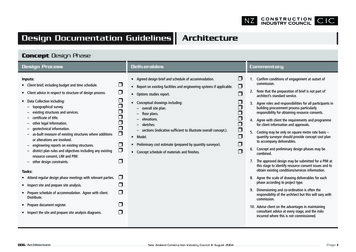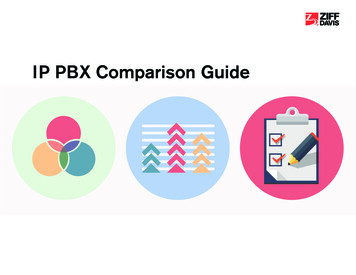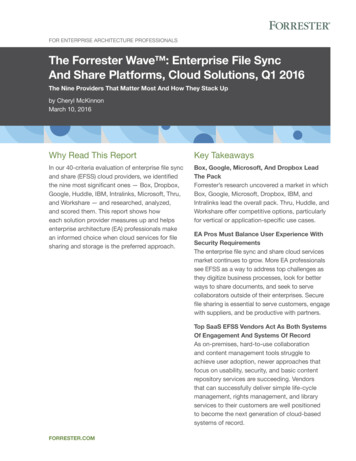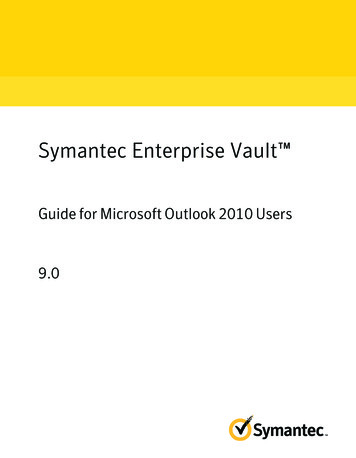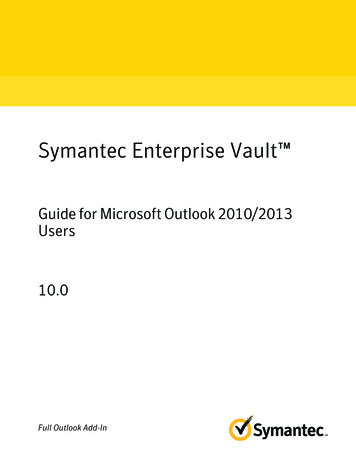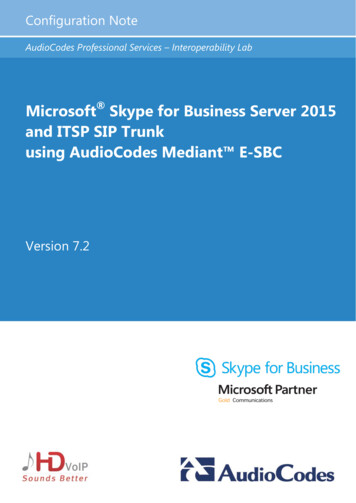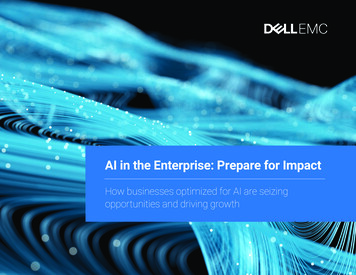
Transcription
1AI in the Enterprise: Prepare for ImpactHow businesses optimized for AI are seizingopportunities and driving growth
2Table of ContentsIntroductionThe Evolution of AI, Machine Learning, and Deep LearningTransforming Business with AI InitiativesOptimizing Infrastructure for Greater AI ValueKeeping Your AI Workloads Safe and SecureSimplify Your AI Journey with Dell Technologies and AMDTurn AI Possibilities into Reality
3IntroductionAccording to Gartner, globalAI-derived business value willreach nearly 3.9 trillion by 2022.1Artificial intelligence (AI) holds incredible promise for today’s enterprises, given its power tounlock valuable insights from mountains of data. Yet most companies (80-85%) are stuckin the AI experimentation stage, with efforts siloed within departments or teams—andlacking any tie to key business objectives.1 It takes a clearly defined AI strategy, backed bythe right business processes and IT infrastructure, to truly maximize AI investments.But what’s the big deal about AI anyway? Hasn’t it been around for years? AI, machinelearning (ML), and deep learning (DL) technologies are rapidly converging, due to multiplefactors. In addition to recent breakthroughs in AI algorithms, the high-performancecomputing (HPC) solutions needed to power AI workloads are more accessible andaffordable than ever. Meanwhile, there’s more data available to fuel AI and drive actionableresponses in real time.This eBook will look at how to get more value from AI initiatives, so your company hassmarter insights to drive operational efficiencies, transform decision making, and acceleratebusiness growth. We’ll explore the meaning of AI, its impact on your business processes, ITinfrastructure, and enterprise security, as well as how to choose the technology foundationto power it all.
4ARTIFICIAL INTELLIGENCEA program that can sense, reason, act, and adapt.MACHINE LEARNINGAlgorithms whose performance improve asthey are exposed to more data over time.DEEP LEARNINGA subset of machine learning in whichmulti-layered neural networks learnfrom vast amounts of data.The Evolution of AI, Machine Learning,and Deep LearningFounded as a research field in the mid-1950s, AI is an umbrella term for using machineintelligence to mimic—and surpass—what humans can do. The practices of machinelearning and deep learning are what make AI possible.Machine learning refers to the process of “training” a machine to perform a specific task.Rather than a team of programmers writing the specific instructions for accomplishing atask, the machine uses algorithms to parse large amounts of data, analyze it, and “learn”from it. Deep learning is a machine learning technique that uses neural networks as theunderlying architecture for training models.The training algorithms used for deep learning are compute-intensive, so HPCinfrastructure is essential for accelerating AI workloads. Fast compute power and storage,along with massive memory capacity and high-bandwidth connectivity, are all keyelements for efficient processing—speeding the time to deeper, actionable insights.84%84% of C-suite executives believethey must leverage AI to achievetheir growth objectives.276%76% say they struggle with howto scale AI across the business.2Now, thanks to technology leaps, the affordability of HPC solutions, and an explosionof data, AI is moving from its academic roots to the forefront of business and industry.Companies can use AI to gain greater insights and garner value from the data theycapture and store, but a key challenge is how to scale a few AI pilot projects intoenterprise-wide initiatives. That’s where AI-driven business processes and AI-optimizedinfrastructure come in.
5Transforming Business with AI InitiativesAcross a wide range of industries, companies are embracing the power of AI applicationsand HPC systems to make their businesses smarter, more responsive, and more secure.AI-driven systems help you uncover new data insights for solving business problems andexploiting market opportunities. But to be effective, your business decision models needto be people-centric (that is, client-centric) and backed by infrastructure designed for themost resource-intensive workloads.Examples of how AI-driven business processes enable people-centric decision making:AI will start to get involved infailure recognition, predictiveanalytics, and other functions.It will enable IT to do moreand at faster rates, growinginfrastructure withoutnecessarily growing staff.The critical timeframe forthis trend is between2021 and 2023.3 Customer engagement: By analyzing customer behavior and transaction history, youcan tailor products and services to better meet different customers’ needs. Fraud prevention: With real-time analysis of online transactions, you can identifysuspicious activity and prevent potential fraud—without disrupting legitimate business. Preventive maintenance: To improve employee productivity, you can track equipmentusage and service history to know when preventive maintenance is needed.However, many companies struggle with how to turn their siloed, “proof of concept” AIprojects into company-wide implementations. To successfully scale AI initiatives, yourbusiness needs a holistic data and analytics strategy. Business processes need to evolve,based on a clear enterprise vision, structure, and governance. And once you’ve instilledthe right AI capabilities and mindset in the organization, you’ll need to ensure yourinfrastructure is ready to deliver your data-driven insights—with unprecedentedspeed and scalability.
63.5xUsing modernized IT to support AI,companies are 3.5x more likely touncover new market opportunitiesvia analytics, and reduce the cost ofbusiness operations by nearly triplethe rate of those with aging IT.567%Process up to 67% more data persecond with Dell PoweEdge R7525powered by AMD EPYC 7502processors.6Optimizing Infrastructure for Greater AI ValueTo get the most value from your AI initiatives, you’ll need to optimize the underlying infrastructureto improve day-to-day operations and enable innovation. Modernized servers include the latestautomation technology, which can free up time and resources within I&O (infrastructure andoperations) for AI and machine learning pursuits, while also delivering faster, deeper insightsacross the organization.In fact, when you upgrade to modern servers with automation capabilities, you can expect:4 43% faster deployments 38% faster updates of applications 43% higher systems reliability 37% less time spent on routine, manual IT infrastructure managementAI-optimized servers should have high-performance processors for robust data-crunching,advanced graphics cards for workload acceleration, substantial storage for working withmassive data sets, and extensive memory for supporting multiple parallel operations. The goodnews is that these AI-optimized platforms are available now, using off-the-shelf technology, todeliver industry-leading performance per dollar—so you can make strategic investments in IT todrive better business outcomes.In addition, a trusted technology partner can simplify your AI journey, from strategy toimplementation to ongoing optimization. Experts can help ensure that each hardware andsoftware component is configured correctly and integrated seamlessly into the environment.The result is a faster time to value, with measurable returns aligned with your enterprise vision.
7Keeping Your AI WorkloadsSafe and SecureIn today’s business world, cybercriminals are lurking everywhere—looking for newways to gain unauthorized access to sensitive data. Some savvy criminals even use AIin their exploits, so your company has to use AI to fight AI, or risk leaving your criticalassets exposed. Security has to be prioritized at every layer of your IT infrastructure,especially as AI, the Internet of Things (IoT), and other evolving technologies introducenew vulnerabilities. Data privacy, digital ethics, and security best practices are vital formaintaining trust and ensuring business success.Through 2022, over75% of data governanceinitiatives will notadequately consider AI’spotential security risksand their implications,resulting in quantifiablefinancial loss.7To protect against emerging threats, your infrastructure should be AI-ready with end-toend security. At the platform level, your systems should include built-in security with: A secure hardware root-of-trust. If the server BIOS is corrupted or compromised, theprocessor should prevent the firmware from booting. Hardware-accelerated memory encryption. The processor should protect data-in-usewith full-stack encryption, using secure key generation and key management. Virtual machine (VM)-level encryption. The processor should also protect againsthypervisor corruption with hardware protection, which is a more robust solution thansoftware protection. Server-level security technology. Beyond secure processors, the server platformshould offer digitally signed firmware updates, automatic BIOS recovery, firmwarerollbacks, and systems lockdowns to prevent configuration “drift.”Trusted vendors also build security into their manufacturing processes and ensure asecure supply chain. This includes verifying the authenticity of components or parts, usingtrusted suppliers, and physically securing the build environment, the system build process,and the final shipments to customers.
8Simplify Your AI Journey withDell Technologies and AMDWorld Records set new standardsfor in-memory Big Databenchmark @1 TB and @3 TBDell PowerEdge R7515 servers withAMD EPYC 7542 processors set anew standard for performance andprice-performance with a worldrecord TPCx-HS V2 benchmarkresult at both the 1 TB scale factor 8and the 3 TB scale factor.9With the power of AI and machine learning, your company can drive innovations and improveoperations. And with trusted technology partners like Dell Technologies and AMD on your side,your AI journey can be worry-free. With an unrivaled portfolio of modern infrastructure andAI-optimized solutions, backed by dedicated AI experts, Dell EMC can help you capitalize on thelatest technologies—saving you time and money, while reducing risk.Dell EMC PowerEdge servers, powered by 2nd Gen AMD EPYC processors, are engineeredwith the right balance of performance and low TCO for AI workloads. Built for processingmassive amounts of data, the platform features the highest-performance architecture, generousmemory and storage options, and industry-leading security.What’s more, Dell Technologies’ worldwide HPC and AI Centers of Excellence make it easier tocollaborate with some of the brightest minds in AI, HPC, and data analytics. The expert networkof resources can help you fine-tune your solutions, test new technologies, and share bestpractices for optimized results.
9Turn AI Possibilities into RealityFaster Machine Learning; processimages in 55.8% less timeFinish machine learning preparationtasks on Kubernetes containersin less time with the Dell EMCPowerEdge R7525.10An end-to-end portfolio of AI-optimized technologies is just the start. With a team of AI expertsthat can bridge the gap between IT, data scientists, and the lines of business, Dell Technologiesmakes it easier to advance your AI initiatives—delivering faster insights for lasting value. Whywait to take the guesswork out of your AI journey?LEARN MORE ABOUT POWEREDGESERVERS POWERED BY AMDDELL TECHNOLOGIES HPC ANDAI CENTERS OF EXCELLENCEThe AMD EPYC SoC’s no-compromise singlesocket solution helps you optimize the computepower for your application. Incredibly highcore counts, memory capacity and bandwidth,and massive I/O help enable breakthroughperformance and lower cost of ownership formany applications including big data analytics.
10Learn more aboutDell EMC PowerEdgesolutions]Contact a DellEMC ExpertView more resourcesfor Dell EMCPowerEdge serversand solutionsJoin theconversation with#PowerEdge1Gartner, “Gartner Says Global Artificial Intelligence Business Value to Reach 1.2 Trillion in 2018,” April 25, on-in-20182Accenture, “AI: Built to Scale,” November 2019.https://www.accenture.com/ -Built-to-Scale-PDF-Report.pdf3Gartner, “Gartner Top 10 Trends Impacting Infrastructure & Operations for 2020,” December 10, 2019. Gartner Top 10 Trends ImpactingInfrastructure & Operations for 20204Forrester Research commissioned by Dell EMC, “Insights From Modernized IT: How To Achieve The Greatest Success As You Automate,”November pdf5Based on ESG Research Insight Paper commissioned by Dell EMC, “Measuring the Value of Data and Analytics Inside Modernized ITDepartments,” August ts.pdf6Based on Principled Technologies Spark report commissioned by Dell Technologies, April 2020.Principled Technologies EPYC-7502-Spark-report-0420.pdfs7Gartner, “Top 10 Strategic Technology Trends for 2020,” October 21, 2019.https://www.gartner.com/doc/reprints?id 1-1YAFQIDG&ct 200206&st sb8TPCx-HS benchmark results at 1 TB scale factor for the Apache Spark framework are: 11.73 HSph, 38,182.70 /HSph, 10/15/2019system availability. Full disclosure report available on the TPC website at: http://www.tpc.org/55359Single-socket AMD EPYC TPCx-HS benchmark results at 3 TB scale factor for the MapReduce framework for the AMD EPYC 7542processor: 11.62 HSph, 38,544.15 /HSph, 10/15/2019 system availability. Full disclosure report available on the TPC website at:http://www.tpc.org/5536Based on Principled Technologies Kubernetes report commissioned by Dell Technologies, April 525-EPYC-7502-Kubernetes-report-0420.pdf10 2020 Dell Inc. or its subsidiaries. All Rights Reserved. Dell, EMC and other trademarks are trademarks of Dell Inc. or its subsidiaries.AMD, the AMD Arrow logo, AMD EPYC, and combinations thereof are trademarks of Advanced Micro Devices, Inc. Other trademarks maybe trademarks of their respective owners. Reference Number: DEL-0420-2192
and Deep Learning Founded as a research field in the mid-1950s, AI is an umbrella term for using machine intelligence to mimic—and surpass—what humans can do. The practices of machine learning and deep learning are what make AI possible. Machine learning refers to the pr



